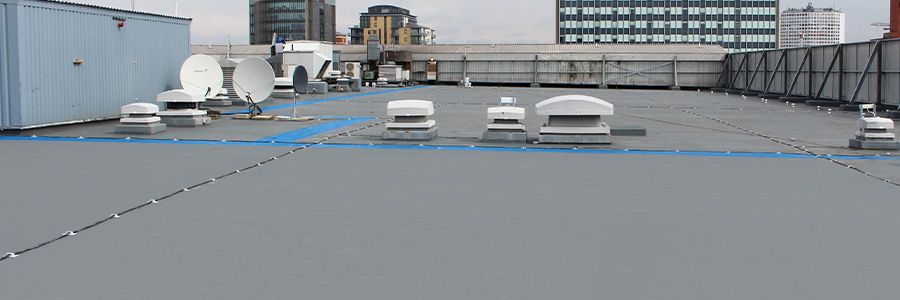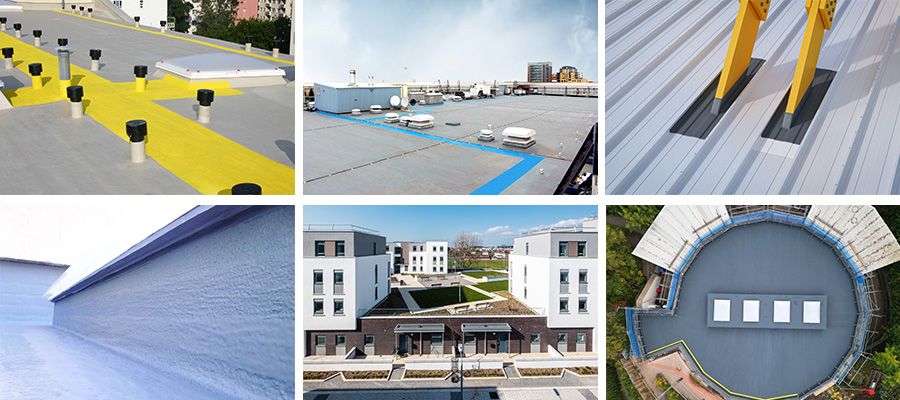If you’re looking to waterproof a flat roof, there are three common choices. The first is the use of sheet membrane. The second is a bitumen based option such as felt or asphalt. While the third is the use of cold liquid products. All three options are widely used.
So, why would you choose cold liquid applied waterproofing over the other two?
What is a cold liquid waterproofing system?
Cold liquid waterproofing is a relatively self-explanatory process. As the name suggests, it involves the creation of a membrane, cold applied in liquid form, typically using rollers.
There are various types of liquid waterproofing resins, and they all work in slightly different ways. Some cure through exposure to air or rely upon solvent evaporation. Others cure through a chemical reaction when the separate components are combined, independent of environmental factors. Either way, the result is the creation of a seamless membrane that can protect the building from water ingress and damage.
What are the different types of cold liquid applied waterproofing?
At Triflex, we are specialists in resin technology with a range of advanced Polymer resins for use on flat roofs. Triflex PMMA waterproofing systems (Polymethyl methacrylate) creates a liquid membrane with flexible properties, quick cure times, and the ability to be used on vertical surfaces as well as horizonal. But there are other resin technologies available, including:
- Polyurethane (1 and 2 component)
- GRP - Rigid unsaturated polyester
- UP - flexible unsaturated polyester
- STPE or STPU (Silane terminated Polyester or Polyurethane)
- Polyurea
- Solvent based liquid rubber
What are the benefits of cold liquid applied waterproofing?
There are several reasons to choose cold liquid applied waterproofing.
The simplicity of application
With no hot works required, insurers can be quickly satisfied for any repair or refurbishment project. With no hot work permits, torches, burners, heating equipment or fire safety watches, the risk of fire can be negated providing a simpler and safer approach to waterproofing.
If you select the right format, cold liquid waterproofing can be rapidly applied. With some self-terminating, polymer-based solutions, you can cover a surface edge-to-edge, without the need of termination bars. Applied as a wet on wet process with an embedded reinforcement fleece, it's quick and easy to install, ensuring that you can create the perfect coverage for minimum effort.
Versatility of application
Triflex PMMA cold liquid waterproofing can be applied to almost any surface type. From single-ply (including EPDM), to bituminous membranes (felt), concrete, timber, metal and even glass, making it a supremely versatile overlay solution. Particularly versatile for areas where two surface types interface, or multiple mixed material surfaces with different coefficients of expansion, cold liquid waterproofing provides excellent waterproofing to unusual forms and details without the need for formers. Unlike some cold liquid waterproofing, Triflex PMMA waterproofing rapidly cures, and is rainproof in 30 minutes, even at low temperatures. That means making a building watertight can be quickly undertaken in the winter months too.
Consistency of coverage and application
As long as application is undertaken by trained installers, with cold liquid waterproofing, you can ensure consistent covering of your surface. Working with a manufacturer such as Triflex with a national network of Authorised Contractors, means that you can be sure of a long lasting, high quality waterproofing solution.
High durability
Not all liquid waterproofing is equal. But if you choose the right solution, you can be confident of a highly durable finish. Ensure that your cold liquid applied waterproofing system has BBA certification for peace of mind. Triflex PMMA Liquid waterproofing systems are UV resistant and hydrolysis resistant, meaning they do not break down under water. That's reassuring, as although the flat roof may be designed to 1:80 falls, the 'as built' reality may result in some areas of ponding water.
Are there any drawbacks to the use of cold liquid applied waterproofing?
If you choose the right format, there are very few limitations to the use of cold liquid waterproofing. But it should be noted that some solutions can only be used on specific surface types, and that solvent-based solutions require consideration of the environmental factors for installation. Poor application can also cause problems, including the formation of air pockets, which can weaken the membrane.
Like most things, the success of cold liquid applied waterproofing depends upon choosing the right system for your needs. Working with a reputable manufacturer who understands the built environment, building regulations and offer on-site and off-site support services means that you will find yourself with a waterproofing solution that will last for decades.


